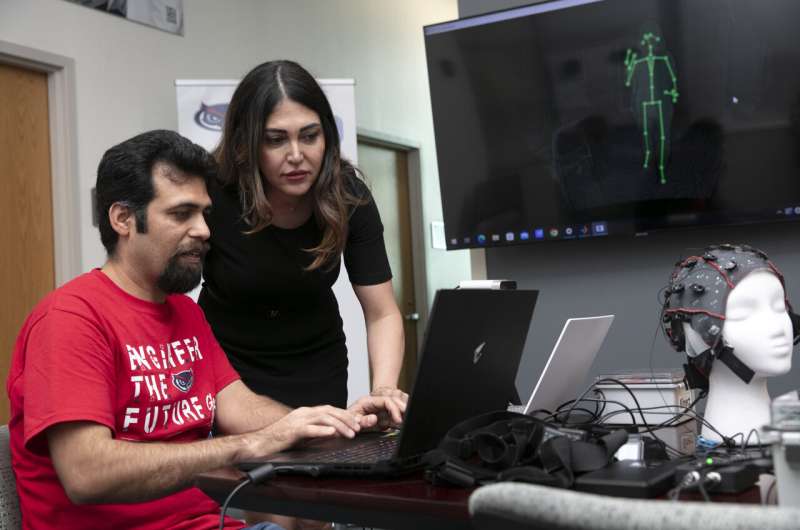This article has been reviewed according to Science X's editorial process and policies. Editors have highlighted the following attributes while ensuring the content's credibility:
fact-checked
trusted source
proofread
'Curved' walking and a depth camera: New tool detects early cognitive decline

A first-of-its-kind study suggests that to detect subtle gait impairments in older adults that often are prevalent in the early stages of cognitive decline, "throw them a curve."
Gait analysis, examining the way an individual stands and walks, is emerging as a valuable, non-invasive complement to cognitive assessments that aid in early diagnosis and management. In clinical settings, gait and balance tests typically focus on a straight walking path.
This new study ventures into a different realm—curved path walking—a more natural yet complex activity. Straight walking is a rhythmic and simpler activity, whereas walking on a curving path requires greater cognitive and motor skills such as a transition time to change directions and correct balance.
College of Engineering and Computer Science researchers at Florida Atlantic University are the first to quantitatively compare the performance of healthy older adults versus older adults with mild cognitive impairment (MCI) in straight and curve walking. MCI is the early stage of cognitive decline and people with MCI have a much higher risk of transitioning to Alzheimer's disease (AD).
For the study, researchers used a depth camera, which can detect and track 25 joints of body movement, to record study participants' gait while performing the two different walking tests (straight versus curve). Signals from the 25 body joints were processed to extract 50 gait markers for each test, and these markers were compared between the two groups using descriptive statistical analyses.
Results, published in the Journal of Alzheimer's Disease Reports,, showed curve walking resulted in greater challenges for the MCI group and outperformed straight walking in detecting MCI. Furthermore, several gait markers showed significant differences between healthy controls and MCI patients.
Gait markers included two macro markers (average velocity and cadence), 24 micro temporal markers (duration of feet for various subphases of the gait cycle, such as stance, swing, step and stride phases), micro spatial markers (location changes of feet for various sub-phases of the gait cycle) and six micro spatiotemporal markers (velocity of feet for various sub-phases of the gait cycle). These markers provided detailed information on the functional performance of the participants during the gait tests.
Findings showed that 31 out of 50 gait markers (62%) were greater for the MCI group than healthy control older adults when the walking tests changed from straight walking to curve walking, and 13 markers showed significant differences between the two study groups.
"Intriguingly, curved walking illuminated notable disparities between our study groups, even for these macro gait markers. The MCI group exhibited a markedly lower average step length and speed during curve walking, coupled with higher variability across most micro-gait markers," said Behnaz Ghoraani, Ph.D., senior author, an associate professor, FAU Department of Electrical Engineering and Computer Science, co-director of the FAU Center for SMART Health, and a fellow, FAU Institute for Sensing and Embedded Network Systems Engineering (I-SENSE).
"The MCI group showed diminished symmetry and regularity in both step and stride lengths for curved walking. They also required extended double support time in various areas, especially while changing directions, which resulted in reduced step speed."
Study findings did not show any significant differences in age and gender distribution between the two groups. However, the two groups had significant differences in body mass index (BMI), years of education and Geriatric Depression Scale (GDS) scores. Participants with MCI had a higher BMI, lower levels of education and higher GDS scores than the healthy older adults.
"Mild cognitive impairment can be an early sign of Alzheimer's disease and other types of dementia," said Ghoraani. "Our comprehensive approach enhances the understanding of gait characteristics and suggests curved path walking may be more sensitive to detect mild cognitive dementia, which can complement cognitive assessments and aid in early diagnosis and management."
AD typically manifests as a decline in cognitive function with a gradual decline in an individual's ability to perform daily activities such as walking. Accurate and early clinical detection of AD remains a challenge. Typical clinical evaluations include a detailed history, comprehensive physical and neurological examination, cognitive testing, blood work and brain imaging. However, depending on the clinical setting, these methods can be time-consuming, costly and outside some clinicians' comfort level.
The study fills this gap by using a novel system to record gait in older adults employing a non-invasive, low-cost, non-wearable and easy-setting depth camera, which is a crucial step in enhancing patient care and intervention strategies.
"These gait markers offer a promising potential as early indicators of cognitive impairment and lay the foundational groundwork for expansive research in this domain," said Stella Batalama, Ph.D., dean, FAU College of Engineering and Computer Science. "Impacts from this study also extend to clinical practice by providing improved methods for screening and monitoring that can be easily replicated with minimal costs and time in the clinic setting."
More information: Curve Walking Reveals More Gait Impairments in Older Adults with Mild Cognitive Impairment than Straight Walking: A Kinect Camera-Based Study, Journal of Alzheimer's Disease Reports (2024). DOI: 10.3233/ADR-230149


















